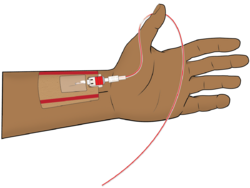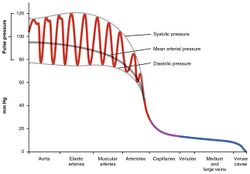Medicine:Mean arterial pressure
| Mean arterial pressure | |
|---|---|
| Medical diagnostics | |
 Representation of the arterial pressure waveform over one cardiac cycle. The notch in the curve is associated with closing of the aortic valve. | |
| MeSH | D062186 |
In medicine, the mean arterial pressure (MAP) is an average calculated blood pressure in an individual during a single cardiac cycle.[1] Although methods of estimating MAP vary, a common calculation is to take one-third of the pulse pressure (the difference between the systolic and diastolic pressures), and add that amount to the diastolic pressure.[2][3] A normal MAP is about 90 mmHg.[4]
Mean arterial pressure = diastolic blood pressure + (systolic blood pressure - diastolic blood pressure)/3
MAP is altered by cardiac output and systemic vascular resistance.[5] It is used clinically to estimate the risk of cardiovascular diseases, where a MAP of 90 mmHg or less is low risk, and a MAP of greater than 96 mmHg represents "stage one hypertension" with increased risk.[3][4]
Testing

Mean arterial pressure can be measured directly or estimate from systolic and diastolic blood pressure by using a formula.[5] The least invasive method is the use of a blood pressure cuff which gives the values to calculate an estimate of the mean pressure. A similar method is to use a oscillometric blood pressure device that works by a cuff only method where a microprocessor determines the systolic and diastolic blood pressure.[6] Invasively, an arterial catheter with a transducer is placed and the mean pressure is determined by the subsequent waveform.
Estimating MAP

While MAP can only be measured directly by invasive monitoring, it can be estimated by using a formula in which the lower (diastolic) blood pressure is doubled and added to the higher (systolic) blood pressure and that composite sum then is divided by 3 to estimate MAP.[2]
Thus, a common way to estimate mean arterial pressure is to take one-third of the pulse pressure added to the diastolic pressure:[2][3][7]
where:
- DP = diastolic pressure
- SP = systolic pressure
- MAP = mean arterial pressure
Systolic pressure minus diastolic pressure equals the pulse pressure which may be substituted in.[5]

Another way to find the MAP is to use the systemic vascular resistance equated (), which is represented mathematically by the formula
where is the change in pressure across the systemic circulation from its beginning to its end and is the flow through the vasculature (equal to cardiac output).
In other words:
Therefore, MAP can be determined by rearranging the equation to:
where:
- is cardiac output
- is systemic vascular resistance
- is central venous pressure and usually is small enough to be neglected in this formula.[8]
This is only valid at normal resting heart rates during which can be approximated using the measured systolic () and diastolic () blood pressures:[9][10]
Elevated heart rate
At high heart rates is more closely approximated by the arithmetic mean of systolic and diastolic pressures because of the change in shape of the arterial pressure pulse.
For a more accurate formula of for elevated heart rates use:
Where
- HR = heart rate.
- DP = diastolic pressure
- MAP = mean arterial pressure
- PP = pulse pressure which is systolic minus diastolic pressure[11]
Most accurate
The version of the MAP equation multiplying 0.412 by pulse pressure and adding diastolic blood is indicated to correlate better than other versions of the equation with left ventricular hypertrophy, carotid wall thickness and aortic stiffness.[12] It is expressed:
where:
- DBP = diastolic pressure
- MAP = mean arterial pressure
- PP = pulse pressure
Young patients
For young patients with congenital heart disease a slight alteration to the factor used found to be more precise. This was written as:
where:
- DBP = diastolic pressure
- MAP = mean arterial pressure
- PP = pulse pressure
This added precision means cerebral blood flow can be more accurately maintained in uncontrolled hypertension.[13]
Neonates
For neonates, because of their altered physiology, a different formula has been proposed for a more precise reading:
where:
- DBP = diastolic pressure
- MAP = mean arterial pressure
- PP = pulse pressure
It has also been suggested that when getting readings from a neonates radial arterial line, mean arterial pressure can be approximated by averaging the systolic and diastolic pressure.[14]
Other formula versions
Other formulas used to estimate mean arterial pressure are:
or
or
or
- MAP = mean arterial pressure
- PP = pulse pressure
- DAP = diastolic aortic pressure
- DPB = diastolic blood pressure
Clinical significance
| 24 hr. MAP category | 24 hr. MAP |
|---|---|
| Normal | < 90 mmHg |
| Elevated blood pressure | 90 to < 92 mmHg |
| Stage 1 hypertension | 92 to < 96 mmHg |
| Stage 2 hypertension | > 96 mmHg |
Mean arterial pressure is a major determinant of the perfusion pressure seen by organs in the body. MAP levels greater than 90 mmHg increase the risk stepwise of having higher risk of cardiovascular diseases, such as stroke, and mortality.[3]
Hypotension
When assessing hypotension, the context of the baseline blood pressure needs to be considered. Acute decreases in mean arterial pressure of around 25% put people at increased risk for organ damage and potential mortality.[19] Even one minute at a MAP of 50 mmHg, or accumulative effects over short periods, increases the risk of mortality by 5%, and can result in organ failure or complications.[20][21]
In people hospitalized with shock, a MAP of 65 mmHg lasting for more than two hours was associated with higher mortality.[22] In people with sepsis, the vasopressor dosage may be titrated on the basis of estimated MAP.[2]
MAP may be used like systolic blood pressure in monitoring and treating target blood pressure. Both are used as targets for assessing sepsis, major trauma, stroke, and intracranial bleeding.[23]
Hypertension
In younger people, elevated MAP is used more commonly than pulse pressure in the prediction of stroke. However in older people, MAP is less predictive of stroke and a better predictor of cardiovascular disease.[24][25]
See also
References
- ↑ "Pulse pressure and mean arterial pressure in relation to ischemic stroke among patients with uncontrolled hypertension in rural areas of China". Stroke 39 (7): 1932–1937. July 2008. doi:10.1161/STROKEAHA.107.510677. PMID 18451345.
- ↑ 2.0 2.1 2.2 2.3 "Calculating the mean arterial pressure (MAP)". Nursing Center. 8 December 2011. https://www.nursingcenter.com/ncblog/december-2011/calculating-the-map.
- ↑ 3.0 3.1 3.2 3.3 3.4 "Association of Fatal and Nonfatal Cardiovascular Outcomes With 24-Hour Mean Arterial Pressure". Hypertension 77 (1): 39–48. January 2021. doi:10.1161/HYPERTENSIONAHA.120.14929. PMID 33296250.
- ↑ 4.0 4.1 "Understanding Blood Pressure Readings". American Heart Association. 2023. https://www.heart.org/en/health-topics/high-blood-pFressure/understanding-blood-pressure-readings.
- ↑ 5.0 5.1 5.2 "Physiology, Mean Arterial Pressure". StatPearls. Treasure Island (FL): StatPearls Publishing. 2022. http://www.ncbi.nlm.nih.gov/books/NBK538226/. Retrieved 2022-05-22.
- ↑ "Oscillometric measurement of blood pressure: a simplified explanation. A technical note on behalf of the British and Irish Hypertension Society". Journal of Human Hypertension 33 (5): 349–351. May 2019. doi:10.1038/s41371-019-0196-9. PMID 30926901.
- ↑ "Mean arterial pressure calculator". PhysiologyWeb. 2023. http://www.physiologyweb.com/calculators/mean_arterial_pressure_calculator.html.
- ↑ "Mean Arterial Pressure". Cardiovascular Physiology Concepts. Marian University College of Osteopathic Medicine. http://www.cvphysiology.com/Blood%20Pressure/BP006.htm.
- ↑ "Section 3/3ch7/s3ch7_4". Essentials of Human Physiology. http://humanphysiology.tuars.com/program/section3/3ch7/s3ch7_4.htm.
- ↑ "Cardiovascular Physiology (page 3)". World of Anesthesia. Nuffield Dept.of Anaesthetics, University of Oxford. 12 September 2006. http://www.nda.ox.ac.uk/wfsa/html/u10/u1002_03.htm.
- ↑ "Calculation of mean arterial pressure during exercise as a function of heart rate". Applied Human Science 14 (6): 293–295. November 1995. doi:10.2114/ahs.14.293. PMID 8591100.
- ↑ "Mean arterial pressure values calculated using seven different methods and their associations with target organ deterioration in a single-center study of 1878 individuals". Hypertension Research 39 (9): 640–647. September 2016. doi:10.1038/hr.2016.41. PMID 27194570.
- ↑ "Formula and nomogram for the sphygmomanometric calculation of the mean arterial pressure". Heart 84 (1): 64. July 2000. doi:10.1136/heart.84.1.64. PMID 10862592.
- ↑ "Calculated mean arterial blood pressure in critically ill neonates". Basic Research in Cardiology 88 (1): 80–85. 1993. doi:10.1007/BF00788533. PMID 8471006.
- ↑ "Estimation of mean aortic pressure" (in English). Lancet 354 (9178): 596. August 1999. doi:10.1016/S0140-6736(05)77948-4. PMID 10470724.
- ↑ "Validation of a new formula for mean arterial pressure calculation: the new formula is superior to the standard formula". Catheterization and Cardiovascular Interventions 63 (4): 419–425. December 2004. doi:10.1002/ccd.20217. PMID 15558774.
- ↑ "A call for improving mean aortic pressure estimation". American Journal of Hypertension 18 (6): 891. June 2005. doi:10.1016/j.amjhyper.2004.10.025. PMID 15925755.
- ↑ "Empirical estimates of mean aortic pressure: advantages, drawbacks and implications for pressure redundancy". Clinical Science 103 (1): 7–13. July 2002. doi:10.1042/cs1030007. PMID 12095398.
- ↑ "Hypotension". Principles and Practice of Hospital Medicine (2nd ed.). McGraw Hill. 2017. ISBN 978-0-07-184313-3. https://accessmedicine.mhmedical.com/content.aspx?bookid=1872§ionid=146976893.
- ↑ "Continuous noninvasive arterial blood pressure monitoring using the vascular unloading technology during complex gastrointestinal endoscopy: a prospective observational study". Journal of Clinical Monitoring and Computing 33 (1): 25–30. February 2019. doi:10.1007/s10877-018-0131-6. PMID 29556885.
- ↑ "A Randomized Trial of Continuous Noninvasive Blood Pressure Monitoring During Noncardiac Surgery". Anesthesia and Analgesia 127 (2): 424–431. August 2018. doi:10.1213/ANE.0000000000003482. PMID 29916861.
- ↑ Vincent, Jean-Louis; Nielsen, Nathan D.; Shapiro, Nathan I. et al. (2018-11-08). "Mean arterial pressure and mortality in patients with distributive shock: a retrospective analysis of the MIMIC-III database". Annals of Intensive Care 8 (1): 107. doi:10.1186/s13613-018-0448-9. ISSN 2110-5820. PMID 30411243.
- ↑ "The highs and lows of blood pressure: toward meaningful clinical targets in patients with shock". Critical Care Medicine 42 (5): 1241–1251. May 2014. doi:10.1097/ccm.0000000000000324. PMID 24736333.
- ↑ "Epidemiology of hypertension.". Hurst's The Heart (14th ed.). McGraw Hill. 2017. ISBN 978-0-07-184324-9. https://accessmedicine.mhmedical.com/content.aspx?bookid=2046§ionid=176572658.
- ↑ "Different prognostic impact of 24-hour mean blood pressure and pulse pressure on stroke and coronary artery disease in essential hypertension". Circulation 103 (21): 2579–84. May 2001. doi:10.1161/01.cir.103.21.2579. PMID 11382727.
it:Pressione arteriosa differenziale
 |
